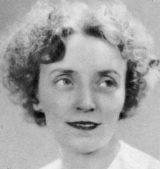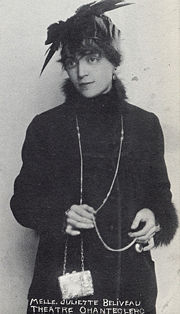
Juliette Béliveau
Encyclopedia

French Canadian
French Canadian or Francophone Canadian, , generally refers to the descendents of French colonists who arrived in New France in the 17th and 18th centuries...
actress and singer, who starred in various radio and television comedies and dramas, as well as in theatre productions. She was also the heroine of a weekly comic strip published by Radiomonde from 1950 through 1954.
Career
Born in Nicolet, QuebecNicolet, Quebec
Nicolet, Quebec is the county seat of Nicolet-Yamaska Regional County Municipality, Quebec, Canada. The population as of the Canada 2006 Census was 7,827...
, Béliveau's first public performance came at the age of ten, when she obtained a role in La Meunière performed at the Monument-National
Monument-National
The Monument-National is a historic Canadian theatre located at 1182 Saint Laurent Boulevard in Montreal, Quebec. Erected between 1891 and 1894, it was originally the Cultural centre of the Saint-Jean-Baptiste Society.-Yiddish theatre:...
by Elzéar Roy's acting group Soirées de famille. It was here she was dubbed "la petite Sarah" by Louis-Honoré Fréchette, a reference to noted actress Sarah Bernhardt
Sarah Bernhardt
Sarah Bernhardt was a French stage and early film actress, and has been referred to as "the most famous actress the world has ever known". Bernhardt made her fame on the stages of France in the 1870s, and was soon in demand in Europe and the Americas...
Béliveau's second job came at age twelve, when she gained a part in La Case de l'oncle Tom
Uncle Tom's Cabin
Uncle Tom's Cabin; or, Life Among the Lowly is an anti-slavery novel by American author Harriet Beecher Stowe. Published in 1852, the novel "helped lay the groundwork for the Civil War", according to Will Kaufman....
which was performed by the acting company of Paul Cazeneuve at the Théâtre National. She went to study for a time at the Académie Marchand, before returning to the theatre in 1902 to play the role of Fanfan in La Famille Benoîton at Théâtre Les Nouveautés. She followed that by playing the title role in Véronica
Veronica
Veronica can refer to:* Veronica , a female given name* Saint Veronica* Veronica * Verónica, Buenos Aires, a town in Argentina-Media and entertainment:* Veronica Ballestrini, an Italian-American country music singer...
in 1903. In 1911, Béliveau took a job with the acting companies Conservatoire Lasalle and Nationascope. She married in 1916, and as a result appeared in significantly fewer performances.
In 1920, Béliveau signed with the Starr label, and recorded a variety of songs, as well as humorous skits with J. Hervey Germain, Elzéar Hamel, Alexandre Desmarteaux, Eugène Daigneault and Ovila Légaré. During the 1920s, she is believed to have starred in about one hundred plays at the Théâtre National. Her performance there in Fridolin led to Gratien Gélinas
Gratien Gélinas
Gratien Gélinas, was a Canadian author, playwright, actor, director, producer and administrator who is considered one of the founders of modern Canadian theatre and film....
writing Fridolinades, which Béliveau would go on to co-star in with Juliette Huot.
In 1935 she made her radio debut in an adaptation of Honoré de Balzac
Honoré de Balzac
Honoré de Balzac was a French novelist and playwright. His magnum opus was a sequence of short stories and novels collectively entitled La Comédie humaine, which presents a panorama of French life in the years after the 1815 fall of Napoleon....
's novel Le Curé de village
Le Curé de village
Le Curé de village is a novel by Honoré de Balzac. It first appeared in La Presse in 1839. Frequently revised, the edited text was published as a separate volume in 1841. It covers themes that Balzac had already developed in le Médecin de campagne - improvements to living conditions in rural areas...
on CKAC in 1935, a programme she would stay with unil 1938. From 1937 until 1959 she was a cast member of Rue principale also aired on CKAC, and from 1939 until 1957 she was a cast member of Un homme et son péché on société Radio-Canada. Her popularity lead to her own radio show, Le Programme Juliette Béliveau which aired on CKAC from 1947 through 1950.
Béliveau appeared in her first movie role in 1949 in Un homme et son péché directed by Paul L'Anglais. She quickly landed several other roles, appearing in Le Gros Bill in 1949, Le Rossignol et les Cloches in 1950 and Ti-Coq in 1952. Her performance as Aunt Clara in Ti-Coq won a Castor award for the best supporting role in Quebec cinema in 1953. Béliveau began appearing in television programmes in
1953 with a role in the soap opera
Soap opera
A soap opera, sometimes called "soap" for short, is an ongoing, episodic work of dramatic fiction presented in serial format on radio or as television programming. The name soap opera stems from the original dramatic serials broadcast on radio that had soap manufacturers, such as Procter & Gamble,...
La Famille Plouffe
La famille Plouffe
La famille Plouffe was a Canadian television drama, more specifically a téléroman, about a Quebec family that first aired in the French-language on Société Radio-Canada in 1953. The show was created to fill a void in francophone television in Canada...
airing on Télévision de Radio-Canada
Télévision de Radio-Canada
Télévision de Radio-Canada is a Canadian French language television network. It is owned by the Canadian Broadcasting Corporation, known in French as Société Radio-Canada. Headquarters are at Maison Radio-Canada in Montreal, which is also home to the network's flagship station, CBFT-DT...
.
Béliveau returned to theatre work in 1956 with a role in Sonnez les Matines. She would continue to work in theatre through the 1950s and 1960s, as well as on television until her death on August 26, 1975 in Montreal
Montreal
Montreal is a city in Canada. It is the largest city in the province of Quebec, the second-largest city in Canada and the seventh largest in North America...
.
Films
- Le Gros Bill (1949)
- Un homme et son péché (1949)
- Le Rossignol et les Cloches (1950)
- Tit-Coq (1952)
Television
- La famille PlouffeLa famille PlouffeLa famille Plouffe was a Canadian television drama, more specifically a téléroman, about a Quebec family that first aired in the French-language on Société Radio-Canada in 1953. The show was created to fill a void in francophone television in Canada...
(1953–1957)
- La feuille au vent (1953–1954)
- Toi et moiToi et moi"Toi et Moi" is Namie Amuro's 13th single under the Avex Trax label, released on July 7, 1999.-Overview:"Toi et moi" is French for You and Me. The song was used as the ending theme to the Japanese version of the second Pokémon movie, Revelation Lugia. Although she had already experimented with...
(1954–1960)
- Les quat' fers en l'air (1954–1955)
- Grandville, P.Q. (1956)
- Les Belles Histoires des pays d'en hautLes Belles Histoires des pays d'en hautLes Belles Histoires des pays d'en haut is a Canadian television drama series, which aired on Radio-Canada from 1956 to 1970. One of the longest-running programs in the history of Canadian television, the series produced 495 episodes during its 14-year run and was one of the first influential...
(1956–1970)
- La Pension Velder (1957–1961)
- Sous le signe du lionSous le signe du lionSous le signe du lion is a Quebec television series comprising thirty 30-minute episodes, directed by Jean-Pierre Sénécal and broadcast in 1961. A two-season remake was broadcast in 1997 and in 2000. The original screeplay was written by Françoise Loranger. Hélène Pedneault adapted it in 1997 and...
(1961)
- Le pain du jour (1962–1965)
- Septième nord (1963–1967)
- Rue de l'anse (1963–1965)
- Rue des PignonsRue des PignonsRue des Pignons was a French-Canadian TV series which ran from 1966 to 1977. Radio-Canada has reportedly lost most of the episodes of the series, only managing to trace about 35 of the 414 episodes from 1966 to 1977...
(1966–1977)

